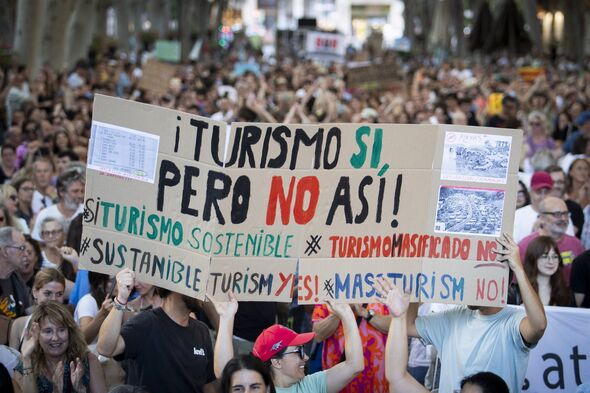Residents of the Canary Islands are growing increasingly frustrated by overtourism, claiming their idyllic paradise is becoming a prison due to the surge in tourist numbers.
In 2023, an astonishing 5.7 million British tourists flocked to the Canary Islands seeking sun, sea, and sand. However, this influx has sparked significant backlash, with locals decrying what they consider an “unsustainable” tourism model that’s pushing them to the brink.
In April, around 50,000 protesters took to the streets, brandishing banners that read “Canarias tiene un limite” – The Canaries have a limit. These demonstrators are calling for a cap on tourist numbers to maintain a sustainable and affordable way of life on the islands.
Meanwhile, residents are grappling with transportation issues, with many feeling stranded due to erratic flight services, as reported by the Mirror.
Tenerife North-Ciudad de La Laguna Airport frequently faces disruptions from gusty winds, Saharan dust clouds, and dense fog, resulting in grounded, delayed, or diverted flights, often to Gran Canaria. When weather conditions worsen, there are limited options to assist those affected by flight disruptions.
“The major problem is that it’s the model of massive tourism that is intransigent in the island… [for] decades, and it’s just destroying the island… and the life of the residents here,” protester Lydia Morales told the BBC in April. “We are feeling we’re being pushed away, our priorities are not taken in consideration.”
“We’ve reached the point where the balance between the use of resources and the welfare of the population here has broken down, especially over the past year,” said Víctor Martín, a spokesperson for the collective Canarias se Agota (The Canaries Have Had Enough) said in the Guardian.
In 2022, Tenerife alone hosted 2.3 million British visitors, with the Canary Islands also featuring popular holiday spots like Gran Canaria and Lanzarote. However, residents of the smaller islands, such as El Hierro and La Gomera, face unique challenges. With populations around 100,000, these islanders feel the impact of tourism more acutely.
For locals on these smaller islands, simple tasks like visiting the doctor, shopping for groceries, or visiting family can become arduous if they start late in the day. The first flight into El Hierro is at 8:35 a.m. from Tenerife, and the early ferry to La Gomera arrives at 9:35 a.m. Currently, there are six daily flights between El Hierro and Tenerife and just one round-trip ferry service per day.
From 2025, El Hierro will face further isolation after 5:50 p.m. once the last plane departs. The only ferry will leave at 2:00 p.m., with a return service at 5:30 p.m. La Gomera has limited travel links to Tenerife with just two daily flights and six boat sailings, with the last flight at 5:50 p.m.
Fabiola Gonzalez, a La Gomera local, expressed her frustrations to El Confidencial, saying:”It’s horrible. First, I have to coordinate schedules with available flights to have enough time for everything; then hope there are no traffic jams on Tenerife’s highway to get to the airport on time and, with luck, that there are no delays or cancellations due to bad weather.”
Another local, preferring to remain anonymous, highlighted the struggle of being “cut off” after nightfall, especially during winter months. In emergencies, a helicopter service is available to transport patients to Tenerife.
Angel Pinero, the former mayor of Valle Gran Rey, voiced his frustration about the unused new dock at Valle Gran Rey.
“It is a pity that due to political laziness there are no connections to the port of a municipality that is the largest tourist centre and the second most populated in La Gomera’, he said. “Only in summer there are more people here than in the rest of the island.”
